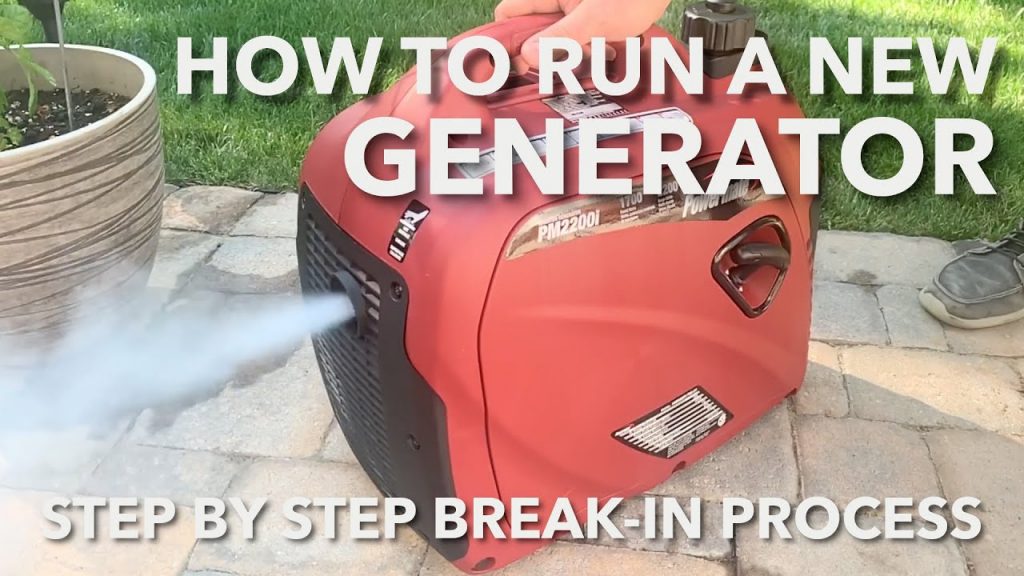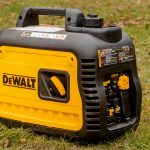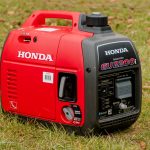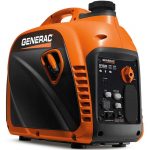Breaking in a new generator is an important part of the process of setting it up correctly. It ensures that the generator will run optimally, and last longer. To break in a new generator, you should run it for several hours. This should be done on a regular basis to ensure the generator is broken in properly. Ideally, you should run your generator for at least a few hours every day for the first week or two.
This will help the engine to become more efficient, and it will also allow you to adjust any settings that may be necessary. Once the generator has been broken in, you should continue to run it regularly. This will help to keep the engine running smoothly and will help to extend its life. It is also a good idea to check the oil levels, spark plugs, and air filters regularly to ensure the generator is running in peak condition. By properly breaking in a new generator, you can ensure that it lasts for many years to come. It is an important process that should not be overlooked, as it can help to prolong the life of your generator.
Does it hurt a generator to run without load?
Generally speaking, it is not recommended that you run a new generator without load. This is because the generator needs to be broken in with a load on it in order to properly lubricate its internal components. Additionally, running a generator without a load can cause an increase in temperature that can cause damage over time. When breaking in a new generator, you should start by running it with a light load on it, such as a fan or light bulb. This will help reduce the strain and heat on the engine and will provide the proper lubrication to its components.
Once the generator has been running with the light load for a while, you can gradually increase the load until it is running at full capacity. Also, it is important to make sure that the generator is properly maintained and serviced during the break-in period. This will ensure that it runs smoothly and efficiently when it is needed. Additionally, it is important to have spare parts and other supplies on hand in case of any unforeseen issues. Overall, it is not recommended to run a new generator without load. This can cause damage over time and can lead to costly repairs or even replacement of the generator. Therefore, it is important to take the time to properly break in a new generator by running it with a light load and gradually increasing the load until it is running at full capacity.
How many days straight can you run a generator?
Learning how to break in a new generator is important to ensure its longevity. One part of the process is running the generator for a certain number of days straight. Generally speaking, you should run a new generator for at least 10 days straight before doing any other maintenance. This will give the generator time to settle in, and ensure that any mechanical problems that arise can be identified quickly. During this period, you should also ensure that the generator is running at a steady pace.
Varying the load too much during this time can put unnecessary strain on the machine, and can cause lasting damage. It is also important to keep a close eye on the generator during the break-in period. Check the oil levels, radiator temperature, and exhaust levels regularly to ensure that everything is in order. Finally, keep in mind that a generator is a mechanical device and can wear down over time. To ensure maximum efficiency and longevity, make sure to follow the manufacturer’s instructions and break in the generator properly.
How long can a new generator sit without being used?
If a new generator is not broken in correctly, it can lead to poor performance and even damage the generator. When breaking in a new generator, one of the most important things to consider is how long it can sit without being used. Generally, a new generator should not sit for more than a week without being used. This ensures that the generator does not have time to start to corrode or have other issues due to lack of use. After the week has passed, the generator should then be turned on and run for a few minutes.
This allows the generator to become familiar with the new environment it is in and ensures that all of its systems are working properly. The break-in period should also include a few other steps. This will ensure the generator is running at its best and is able to provide the most power possible. This can include checking the oil levels and adding new oil if necessary. It is also a good idea to check the spark plug, fuel filter and air filter to make sure there are no blockages that can lead to a decrease in performance. Overall, when breaking in a new generator, it is important to keep in mind how long it can sit without being used. Generally, new generators should not be left idle for longer than a week, and should be checked regularly throughout the break-in period. Doing so will ensure the generator is able to operate at its best, providing the most power possible.
Should I put fuel stabilizer in my generator?
One key component of breaking in a new generator is making sure that the fuel is stabilized. Fuel stabilizer can help protect against the formation of gum and varnish deposits, which can lead to engine failure. Using fuel stabilizer in your new generator is a good idea, as it helps to keep the fuel clean and free of contaminants. It can also help to extend the life of your generator and its fuel system components, as contaminated fuel can cause corrosion and other problems. Fuel stabilizer should be added to the tank before each filling, to ensure that the fuel is properly stabilized.
This will create an environment in which your engine components are better protected from damage caused by corrosion and deposits. Adding fuel stabilizer is also beneficial for storing your generator for extended periods of time. Stabilizer helps to keep the fuel from degrading and becoming unusable. This will help to ensure that your generator is ready to go when you need it, no matter how long it has been in storage. In conclusion, adding fuel stabilizer to your new generator is an important step in preserving its life and ensuring that it runs optimally for years to come. It’s an easy and relatively inexpensive way to protect your investment and get the most out of your generator.
Is it OK to run a generator all night?
It is generally not recommended to run a generator all night, especially if you have just purchased a new one. Without giving the generator the chance to break in and become accustomed to its surroundings, you risk the possibility of damaging the engine and shortening its lifespan. The best way to break in a new generator is to run it at low RPMs for the first few hours. This gives the engine a chance to get used to the environment and helps lessen the wear and tear. It’s also important to check the air filter and oil levels before and after every use, and to replace them as needed.
Once the engine has had a few hours to adjust, you can start running it at full power. Slowly increase the RPMs over an hour or two, and make sure the engine is cooled down properly. It is a good idea to plan short breaks in between the longer running periods, so that the engine can cool down and you can check the oil levels once again. It’s important to remember that running a generator all night is not recommended, as it can cause the engine to overheat and lead to further damage. Proper maintenance and gradual use of the generator will ensure it runs for many years to come.
Do I need to break-in my WEN generator?
Breaking in a new generator is important for helping to ensure a longer generator life. The break-in period helps to ensure that all of the parts in the generator are properly lubricated and operating correctly. If you own a WEN generator, you should definitely break it in before using it. It is important to follow the manufacturer’s instructions when doing this. Generally the break-in process involves running the generator for a few hours at a low load before increasing the load.
This helps to warm up the engine, allowing it to operate at its peak efficiency. During the break-in process, it is important to check the oil level regularly. You should also check the other areas of the generator to make sure they are functioning properly. By taking the time to break-in your WEN generator correctly, you can help ensure that your generator will last for a long time. In the end, the result is worth the effort for the added convenience and reliability your WEN generator can provide.
How long should you run a generator before giving it a break?
When you are breaking in a new generator, it is important to pay attention to how long you run it for. Generally, it is recommended to run it for about 30 minutes before taking a break. This will help to ensure that the generator is properly broken in and all the parts have had a chance to warm up. After the 30 minutes, you should give the generator a break for 10-15 minutes. During this time, you should check the oil and coolant levels to make sure they are at the proper levels.
Additionally, you should check the engine and all its components to ensure everything is running smoothly. It is also important to keep an eye on the temperature of the generator and make sure it is not getting too hot. If you find that the engine is overheating, you should stop running the generator and give it a longer break to allow it to cool down. After this initial break-in period, you can continue to run the generator for longer periods of time, but you should still take regular breaks in between. This will help to make sure that it is properly maintained and that any potential issues are identified quickly. Overall, when breaking in a new generator, it is important to pay attention to how long you run it for and take regular breaks in between. This will help to ensure that the generator is running properly and that any potential issues are identified quickly.
Is it OK to run a generator non stop?
Running a generator non-stop is not necessarily the best way to break in a new generator. In order to give the generator a proper break-in period, it’s important to allow the engine to warm up and cool down gradually. Typically, a new generator should be broken in over 10-12 hours of operation. This should include a few minutes of idle time, followed by 10-15 minutes of run time, then a few minutes of idle time again. This process should be repeated until the full 10-12 hours have been completed.
It is important to note that the generator should be run at low loads (less than 50% of the maximum load) during break-in. This will help to ensure that the engine runs smoothly and evenly, and that all of the components are properly lubricated. In addition, it is important to keep an eye on the oil level and any other maintenance items during the break-in period. This will help to ensure that the generator is running properly and will help to extend its lifespan. Finally, after the break-in period is complete, it is important to follow the manufacturer’s recommended maintenance schedule to help ensure the generator runs optimally for years to come.
Do portable generators need a break?
Portable generators can be a great asset for off-grid adventures or emergencies but must be properly broken in to ensure optimal performance. Knowing how to break in a new generator is an important part of ownership. The break-in process for generators is relatively simple and involves running the generator for short periods of time and varying the load. During this process, the engine is broken in and all the parts are lubricated to ensure it runs properly. Since the generator will be running for a while, it is important to make sure that it has the correct fuel and oil levels.
It is also important to ensure that the engine is adequately cooled. Portable generators do need a break after a period of running, usually after 8-10 hours of operation. During a break, the generator should be shut off and allowed to cool before being restarted. This break is especially important if the generator is being used in an area with higher temperatures. It will also help to ensure that the engine is not overworked and that the parts do not become worn out. Taking proper care of a generator can ensure that it will last for years and provide reliable power when needed. By following the break-in process and making sure to give the generator a break after periods of operation, you can ensure that your generator will continue to perform optimally.






